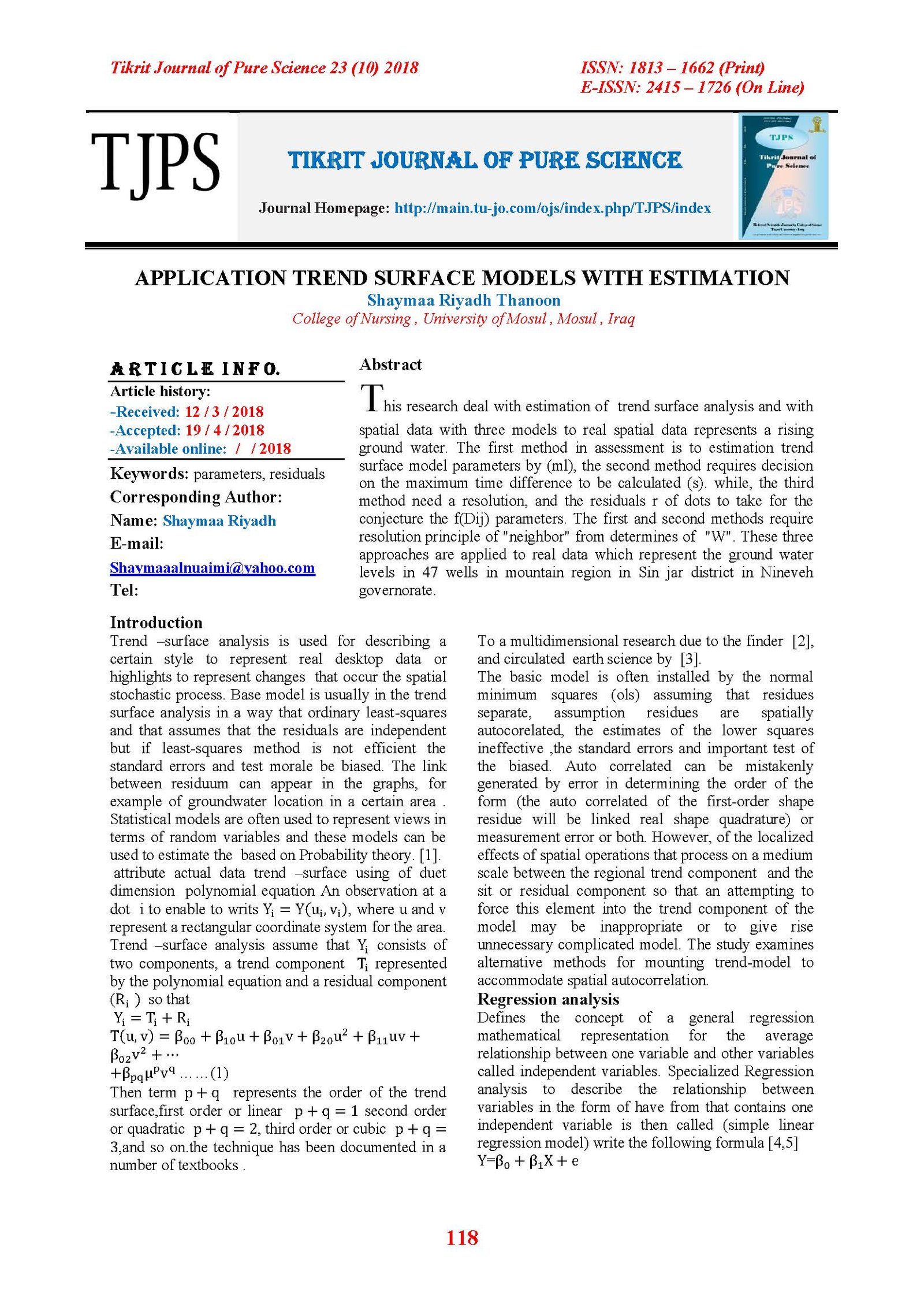APPLICATION TREND SURFACE MODELS WITH ESTIMATION
Main Article Content
Abstract
This research deal with estimation of trend surface analysis and with spatial data with three models to real spatial data represents a rising ground water. The first method in assessment is to estimation trend surface model parameters by (ml), the second method requires decision on the maximum time difference to be calculated (s). while, the third method need a resolution, and the residuals r of dots to take for the conjecture the f(Dij) parameters. The first and second methods require resolution principle of "neighbor" from determines of "W". These three approaches are applied to real data which represent the ground water levels in 47 wells in mountain region in Sin jar district in Nineveh governorate.
Article Details

This work is licensed under a Creative Commons Attribution 4.0 International License.
Tikrit Journal of Pure Science is licensed under the Creative Commons Attribution 4.0 International License, which allows users to copy, create extracts, abstracts, and new works from the article, alter and revise the article, and make commercial use of the article (including reuse and/or resale of the article by commercial entities), provided the user gives appropriate credit (with a link to the formal publication through the relevant DOI), provides a link to the license, indicates if changes were made, and the licensor is not represented as endorsing the use made of the work. The authors hold the copyright for their published work on the Tikrit J. Pure Sci. website, while Tikrit J. Pure Sci. is responsible for appreciate citation of their work, which is released under CC-BY-4.0, enabling the unrestricted use, distribution, and reproduction of an article in any medium, provided that the original work is properly cited.
References
1- Donald, W.; Meals, J. S., Steven, A. Dressing, and Jon, B. (2011). Statistical analysis for monotonic trends, Tech Notes 6, November 2011. Developed for U.S. Environmental Protection Agency by Tetra Tech, Inc., Fairfax, 23.
2- Journel, A.G. and Huijbregts, C.J. (1978). Mining Geostatistics. New York Academic Press, 600. 3- Krumbein, W. C. (1956). Regional and local components in facies maps. Bulletin of the American Association of Petroleum Geologists, 40(9): 2163-2194. 4- Chatterjee, S. and Hadi, A. S. (2015). Regression analysis by example. John Wiley & Sons.
5- Draper, N. R., & Smith, H. (1981). Applied Regression Analysis 2nd ed Wiley. New York, NY.
6- Freedman, D. A. (2009). Statistical models: theory and practice. cambridge university press.
7- Webster, R., & Oliver, M. A. (2007). Geostatistics for environmental scientists. John Wiley & Sons.
8- Haining, R. P. and Haining, R. (2003). Spatial data analysis: theory and practice. Cambridge University Press.
9- Ord, K. (1975). Estimation methods for models of spatial interaction. Journal of the American Statistical Association, 70(349):120-126.
10-Ripley, B. D. (1981). Spatial Statistics. Wiley, New York. 11- Mardia, K. V. and Marshall, R. J. (1984). Maximum likelihood estimation of models for residual covariance in spatial regression. Biometrika, 71(1): 135-146.
12-Agterberg, F.P. (1970), Autocorrelation Function in geology, in geostatistic. A colloquium, ed. D.F Merriam, new york: plenum press, 113-141.
